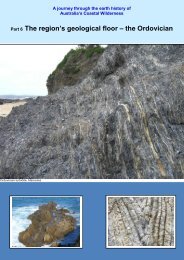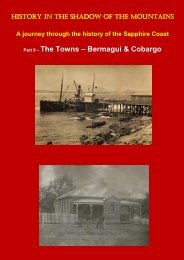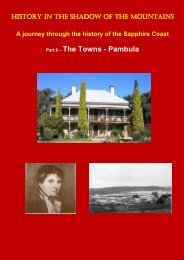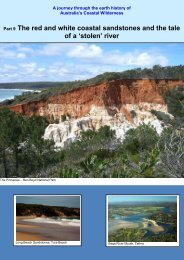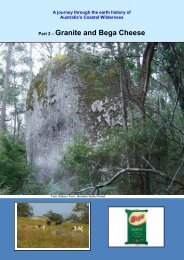A journey through the history of the Sapphire Coast
A journey through the history of the Sapphire Coast
A journey through the history of the Sapphire Coast
Create successful ePaper yourself
Turn your PDF publications into a flip-book with our unique Google optimized e-Paper software.
Bega<br />
(Bega map on <strong>the</strong> last page)<br />
Bega at <strong>the</strong> turn <strong>of</strong> <strong>the</strong> 19 th century.<br />
Squatters moved into <strong>the</strong> Bega Valley from <strong>the</strong> inland areas <strong>of</strong> Monaro and<br />
Braidwood and staked out <strong>the</strong>ir grazing ‘runs’ in <strong>the</strong> early 1830s. Part 4 <strong>of</strong> this series<br />
describes <strong>the</strong>se events, including <strong>the</strong> 1834 arrival <strong>of</strong> <strong>the</strong> Imlay bro<strong>the</strong>rs, who<br />
acquired over 65,000 acres <strong>of</strong> runs and began permanent settlement <strong>of</strong> <strong>the</strong> area<br />
including <strong>the</strong> ‘Tarraganda’ run at ‘Biggah’.<br />
Government Surveyor Parkinson laid out a new town at what is now North Bega (on<br />
<strong>the</strong> site <strong>of</strong> <strong>the</strong> present Bega Cheese Factory). The origin <strong>of</strong> <strong>the</strong> name Bega is not<br />
definitive but is probably based on <strong>the</strong> Aboriginal word ‘Biggah’, which is thought to<br />
mean ‘big camping ground’ or ‘beautiful’.<br />
After a disastrous flood In May 1851 <strong>the</strong> town was moved to higher ground on <strong>the</strong><br />
sou<strong>the</strong>rn side <strong>of</strong> <strong>the</strong> river where it still stands today. In <strong>the</strong> first plan, <strong>the</strong> main street<br />
was Auckland Street, hence <strong>the</strong> construction <strong>of</strong> substantial buildings along that<br />
street. When <strong>the</strong> town centre moved Carp Street became <strong>the</strong> main street.<br />
The first town allotments were surveyed in February 1854 and sold at Eden in August<br />
<strong>of</strong> that year. Eden was <strong>the</strong> only port for communication and transport until Merimbula<br />
port was opened in 1855.<br />
In 1858 <strong>the</strong> Victoria Inn was opened in Auckland Street, and in 1859 <strong>the</strong> Family Hotel<br />
opened on <strong>the</strong> corner <strong>of</strong> Bega and Auckland Streets. Both buildings are still in<br />
existence, <strong>the</strong> Family Hotel is now <strong>the</strong> Bega Pioneers’ Museum. You can obtain from<br />
<strong>the</strong> Bega Pioneers’ Museum a pamphlet for a Bega Heritage Walk that contains a<br />
small map indicating several historic buildings and places. The buildings described<br />
below are just a sample <strong>of</strong> those you can see (http://museumb.freeiz.com ).




